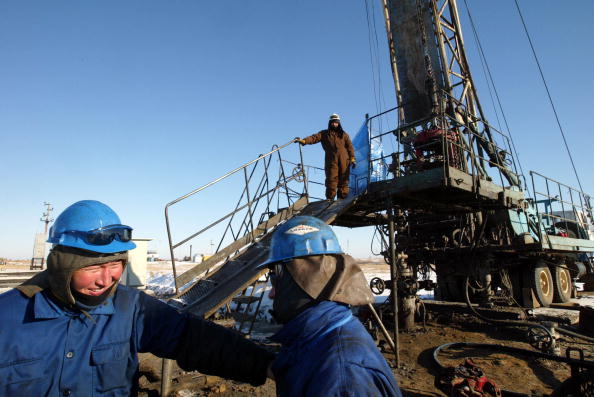
Kazakhstan’s Economy: Planning for the Future
Publication: Eurasia Daily Monitor Volume: 10 Issue: 38
By:

Kazakhstan is well known for the successful transformation of its economy following the country’s independence more than twenty years ago. Its leadership has consistently set ambitious goals to solidify the gains and diversify the economy to meet the challenges of the 21st century. The year 2012 ended on a high note for Kazakhstan—the 2012–2013 Global Competitiveness Report by the World Economic Forum placed the country in 51st place in the overall rating (www.weforum.org), while the World Bank (WB)/International Finance Corporation (IFC) Doing Business 2013 report ranked Kazakhstan 49th out of 185 countries surveyed (www.doingbusiness.org).
Following these successes, the first two months of 2013 have seen a series of high-level meetings involving President Nursultan Nazarbayev, Prime Minister Serik Ahmetov, the Cabinet of Ministers and Kazakhstani entrepreneurs to review economic policy and set new goals for the economic development of the country.
The focal point of the discussions has been “Strategy-2050,” whose objective is to turn Kazakhstan into one of the thirty most developed countries in the world. What sets Strategy-2050 apart from the previous development programs and strategies is the principle of “economic pragmatism” in decision-making and economic planning to build up the competitiveness of Kazakhstan’s economy (https://www.nomad.su, January 24). This principle entails a departure from an earlier focus on achieving higher macroeconomic indicators in favor of economic decision-making based on calculating the internal rate of return (IRR) of all projects, which measures and compares the profitability of investments.
Another important aspect of the January–February 2013 meetings and discussions is their sober and critical assessment of the shortcomings in the country’s economic performance and decision-making, along with a search for ways to overcome them. Thus, while Kazakhstan considers innovative industrialization as the primary vehicle to join the ranks of the thirty most developed countries in the world, there is a clear understanding that success ultimately depends on the quality of human capital and effective institutions (competent government, sound corporate governance, adoption of international business standards, etc.).
To increase the effectiveness of Kazakhstani institutions, a number of concrete steps have been announced. A new Ministry of Regional Development has been established to carry out governmental economic policies more efficiently, support the development of small- and medium-sized businesses in all regions of the country, and eliminate regional imbalances in economic development and social welfare. Another important task of the ministry is to shepherd the implementation of the law on decentralization of power and regional and local self-governance, which is expected to begin in the summer of 2013. The primacy of the new regional approach in economic development of Kazakhstan has been underscored by the simultaneous appointment of Regional Development Minister Bakytzhan Sagintayev as the First Deputy Prime Minister of the country (https://kapital.kz, January 23).
Another institution—the National Development Agency—was created to support the new region-based strategy of economic development. Its task is to channel government investments directly into the regions through the provision of long-term credits to local economic entities and entrepreneurs. The creation of this agency is meant to rectify the lack of long-term credits in Kazakhstan’s economy since the overwhelming majority of credits issued by Kazakhstani private banks are short-term.
Along with launching new agencies, Kazakhstan is taking steps to avoid creating a bloated government. Samruk-Kazyna—Kazakhstan’s National Welfare Fund—has already eliminated 1,173 jobs in 2012, with a further 2,356 to be eliminated in 2013. Other government agencies are expected to follow suit (https://kapital.kz , February 7).
Improving the efficiency of the governmental bureaucracy and developing human capital is of particular concern for the country. According to a recent study commissioned by the Ministry of Labor and Social Protection, Kazakhstan’s labor force will grow to 9.5 million in 2017, compared to 8.54 million in 2012 (www.enbek.gov.kz). At the same time, Kazakhstan, like much of the rest of the world, experiences a shortage of highly qualified managers, engineers and specialists, which globally by 2020 will number around forty million specialists. To solve the country’s immediate need for such specialists, President Nazarbayev suggested attracting the most talented foreign cadres (https://www.nomad.su, January 24). Umirzak Shukeev, the chairman of the Samruk-Kazyna fund, has already announced that the Fund is looking to recruit foreign experts in such fields as sustainable development, risk management, human resources, financial control and reporting (https://kapital.kz, February 20).
The Kazakhstani government also understands that economic development and diversification cannot be achieved without attracting foreign investment. One of the January government meetings was dedicated to adopting measures that would improve this Central Asian republic’s standing in the World Bank’s Doing Business index. Despite its 49th overall place, Kazakhstan’s standing in “Obtaining permission for construction” and “Foreign trade” indicators is 155th and 182nd, respectively. Minister of Economy and Budget Planning Erbolat Dosayev announced that a single “e-window” would be launched in 2013 to facilitate export-import transactions. A pilot system of electronic customs declarations of goods will be tested as well (https://www.minplan.gov.kz, January 22). Such measures, if successfully implemented, should open Kazakhstan up to larger volumes of foreign trade.
Another decision announced by President Nazarbayev will undoubtedly generate interest among foreign investors. In January, he lifted the ban on new subsoil exploration and drilling. He tasked the government to change, if necessary, the laws and regulations to facilitate access to explore new mineral resource fields for foreign investors. In Nazarbayev’s opinion, the country is lagging significantly behind the rest of the world in the exploration of its mineral riches. He cited the figure of $20 per kilometer a year spent in Kazakhstan on new exploration compared to $45 in China, $167 in Australia and $203 in Canada, criticizing a number of ministries for inadequate work in this direction (https://www.nomad.su, January 24). Lifting the ban is another example of rethinking the strategy of economic development, in this case away from an earlier policy of resource nationalism, which should attract even more foreign direct investment (FDI) into the country.
Though the main thrust of the January–February meetings and discussions has been streamlining government management of the economy and devising steps to eliminate existing economic bottlenecks and inefficiencies, their participants have clearly had one eye on the country’s future. The most ambitious of the plans announced by President Nazarbayev on January 23 is turning Astana into a fully “green” city. The first stage will be the building of a pilot “green” district in the Kazakhstani capital. Another step will be powering the Astana 2017 Expo exclusively with alternative sources of energy. Should the experiment prove successful, Astana may well become the first “green” city in the world.




